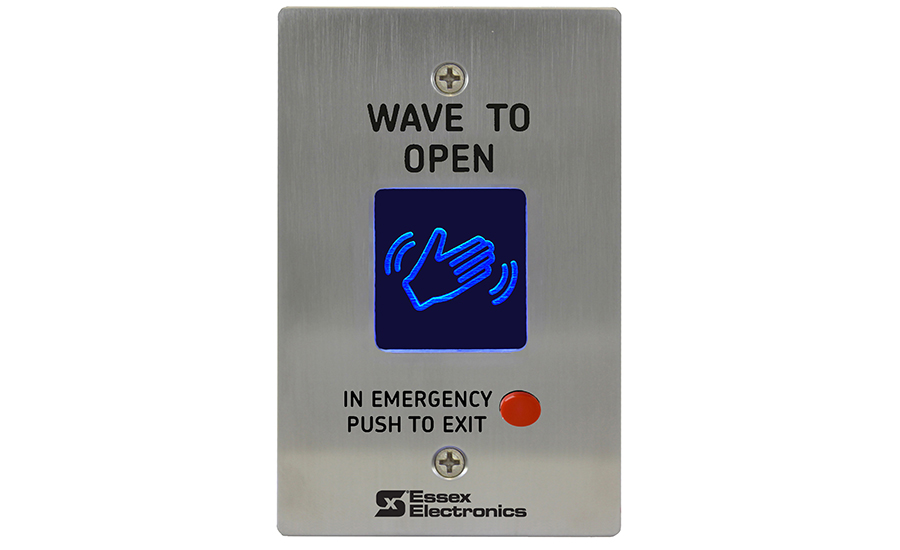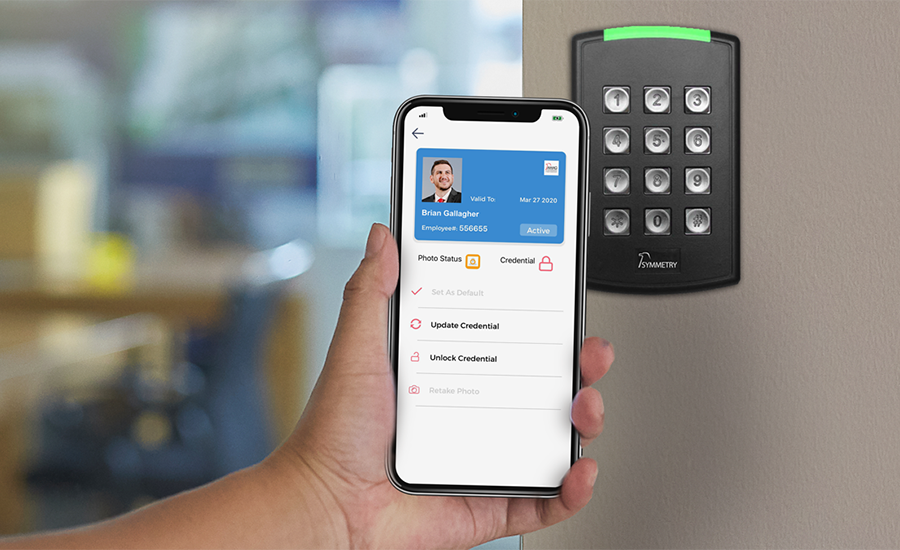In January 2020, when news of the novel coronavirus in China began to circulate across the globe, the design and manufacture of touchless access devices was already well underway in the United States and elsewhere. In reality, they had already been engineered mostly for healthcare related facilities, such as hospitals, clinics, doctor’s offices, and nursing homes.
“Touchless applications were beginning to gain in popularity prior to the pandemic, but the pandemic increased demand and organizations now consider it a priority rather than a nice-to-have future upgrade,” says Chris Randall, director of sales, U.S. AMAG Technology, Hawthorne, Calif.
Consequently, the demand for touchless access skyrocketed overnight, forcing manufacturers that were merely contemplating the touchless market to drop whatever they were doing in order to create an assortment of systems and devices capable of providing exactly what the doctor ordered.
But it appears that demand has waned over the past year.
“I would call it a leveling off of the demand — meaning we’ve seen a consistent amount of requests and orders for touchless access control solutions in 2021 after experiencing peak demand throughout 2019 and 2020,” says Kerby Lecka, marketing director with Security Door Controls, Camarillo, Calif. “That level looks like the new normal going forward.”
Of course, not every element can be complete touch-free, which has also increased the popularity of products with antimicrobial coating.
“I think the pandemic has changed the way architects who design facilities think about personnel safety concerns as related to the spread of a virus,” says Michael Ruddo, chief strategy officer, Integrated Security Technologies Inc., Herndon, Va. “They are designing openings that provide a touchless environment or door hardware that is treated with a coating that is resistant to germs. I think this will become the norm in a number of cases, so the demand will increase as time goes by. Of course, this remains to be seen but I think convenience was always preferred, especially to accommodate the handicapped personnel and visitors; the pandemic just ups the ante, so to speak.”
These mechanical locks, pulls and other hardware also are a big money-maker for those who specify and install them. According to Matt Welty, vice president of Americas at Codelocks, Cucamonga Calif., “Surfaces that must be touched that have an effective antimicrobial coating on them are getting more interest. There is definitely a heightened interest in ‘touchless,’ but so far it has not shifted much in market demand.”

Touchless readers, an automatic door opener equipped with a people sensor and a wave plate on the egress side complete a truly hands-free experience. // IMAGE COURTESY OF ESSEX ELECTRONICS
Fire Code & Egress Openings
Seasoned security integrators know that access control and fire code go hand in hand. NFPA 101, Life Safety Code; NFPA 71, National Fire Alarm Signaling Code; NFPA 70, National Electric Code; and others dictate what you can and cannot do. This is an important consideration where it comes to exit doors equipped with an electromagnetic lock versus those that utilize a simple electrified mechanical lock, or a mechanical lock controlled by an electric strike.
Through the use of an egress motion detector, a mechanical exit bar or a manual REX (Request to Exit) device, such as a touchless wave plate, occupants can easily exit the building under almost any condition. These devices must be listed by a third-party listing service, such as UL, for the purpose to which they are intended.
Touchless REX devices, referred to as “manual releasing devices” in relevant sections of NFPA and ICC fire code can take the form of wave plates as well as manual push bars that fit across an exit door. Not only are these devices subject to the various code sets established by NFPA and ICC, but also UL/ANSI, ADA, and NFC — as well as local and state authorities.
One example is found in Section 21.9.1 of NFPA 72: “Electrically locked doors in a required means of egress shall unlock in the direction of egress where required by other laws, codes, and governing standards.”
Another example is Section A21.9.1: “Doors are commonly locked for various security reasons. Though doors are permitted to be locked to prevent ingress, doors are generally not permitted to be locked to restrict egress unless specifically permitted by governing laws, codes, and standards.” For more information, refer to your NFPA 72 code book.
Where Do We Go From Here?
There’s still considerable push for touchless in the U.S. and throughout the world. Add to this the ongoing desire to further interconnect contactless solutions with a host of security devices and systems.
In some cases this effort is inherent within the physical access technology itself.
“The interesting fact behind many of Boon Edam’s security entrances is that they have always been, by nature, touchless,” says JC Powell, vice president of sales for the Lillington, N.C. manufacturer. “Automatic security revolving doors and portals as well as the Lifeline Optical Turnstiles do not require any physical touch to [make them work]. The biggest change would be the integration with touchless readers such as biometric devices.”
Included in this wish-list is facial recognition as a credential and as a means of authentication. Add to our growing list a means of detecting whether visitors have a mask on in addition to a body temperature reading that falls within a given range — as specified by the user — and now we have an almost perfect touchless access solution on the front end.
“Requests have come from all verticals but we have seen most come from the commercial side where customers are looking to ensure their personnel are able to enter the buildings without having to touch any type of access system or entry,” says Jim DeStefano, senior vice president, Unlimited Technology Inc., Chester Springs, Pa. (SDM’s 2021 Systems Integrator of the Year). “The use of temperature and mask screening has waned in its overall use but is still available in the technology should it be required again.”
Add to this an automatic door opener equipped with a people sensor and a wave plate on the egress side and now the formula is complete.
“Automatic door operators will be in higher demand as the benefits of touchless control application are used across market segments,” says Garrett Kaufman, president, Essex Electronics, Carpinteria, Calif. “Initially, touchless control applications were most common in the healthcare setting, such as in hospitals and long-term care facilities. The recent pandemic has caused a surge in awareness surrounding these products, and now we are seeing them as the preferred option outside of healthcare and in more common settings, such as corporate and retail. Because our concerns and knowledge surrounding COVID-19 and other infectious diseases have increased, the market has truly evolved.”
With this integrated collection of technologies, especially a touchless biometric component, identification and authentication can be done on the fly.
Another element of integration applies to the interplay of access with video surveillance so clients can call up an event or series of events based on a specific moment in time on a specific day. This includes all aspects of security, such as the individual’s credential, a captured image of his person, a video clip of before and after the occurrence, audio (if available), and anything else you can imagine.
“Using the latest technology to combine access events and video footage in one place, Paxton10 will simplify site management and security and offer customers something they’ve never seen before,” says Jonathan Lach, vice president of sales, Paxton Access Inc., Greenville, S.C. “We believe it’s a game-changing system.”
Mobile Credentialing Leads the Way Today
In the years leading up to the start of COVID-19, most of the demand for touchless access originated in the healthcare sector.
“Johnson Controls’ work spans industries, so on any given day we’ll be working with healthcare facilities, commercial real estate, university campuses, K-12 schools, data centers, local and federal government buildings (including affordable housing) and sports and entertainment venues,” says Osvaldo San Martin, vice president and general manager, security solutions, Business Solutions North America at Johnson Controls, Milwaukee.
“That said, we’ve seen most of our requests for touchless access control solutions from the high-end technology retail sector. We think the reason has to do with physical mobility. Mobility-savvy customers look at lowering carbon-footprints by eliminating excess hardware. Touchless access control contributes to this by sometimes removing the hard credential.”
Smartphones, tablets and wearable devices are now leading the way as access manufacturers seek to create an all-inclusive credential that users can employ in almost any situation.
An example of this effort is Secure Technology Alliance and their effort to create a Mobile Driver’s License (mDL) that can be used as proof of an identity, not only for law enforcement during traffic stops, but also other purposes. You might compare it to a state identification card that is often used by an assortment of agencies and entities as proof positive that the holder is who they say they are. In this case, the “card” is contained within a person’s smartphone or tablet.
“Mobile apps provide a convenient solution for organizations using mobile devices or in conjunction with physical credentials for users who are transitioning to a mobile system to gain access to secured doors,” Randall says.

Touchless applications were beginning to gain in popularity prior to the pandemic, but the pandemic increased demand for technologies such as mobile credentials. // IMAGE COURTESY OF AMAG
The Wireless Technologies Involved
There will always be hardwired readers stationed at key entrances on the perimeter of most commercial buildings. Through wireless technology, they will accommodate mobile devices as a form of credential, in addition to traditional plastic credentials. However, for the more progressive technocrats among us, mobile credentials offer a powerful alternative to these hard credentials. Frankly, there are those in our industry that believe the pandemic merely hurried along a trend that was destined to occur no matter what.
“It’s hard to know if the demand for touchless or Bluetooth access control readers and credentials is driven by the pandemic or simply by the availability of the technology, as the two things seem to parallel fairly closely,” says Mark Hillenburg, vice president of marketing with Digital Monitoring Products (DMP), Springfield, Mo. We have definitely seen an increase in demand for our SR3 Bluetooth reader and credentials that are managed and embedded into the user’s phone.
Many of the multi-credential readers on the market are capable of accommodating proximity cards and mobile devices through Bluetooth. According to Hillenburg, the follow-on product that his company hopes to release in first-quarter 2022 will support 13.56KHz and OSDP, in which case it will be capable of accommodating almost any application you can think of.
Honeywell likewise is looking for the continued development of touchless access systems of all kinds. “We’re looking at improving the occupant experience throughout their day from the moment they arrive at work to when they leave,” says Sheeladitya Karmakar, global offering leader, enterprise access, Honeywell Building Technologies, Atlanta. “This includes a system to create frictionless parking access; biometric readers based on facial recognition or fingerprint scanning to better manage access to secure areas; Bluetooth readers in main transit areas to help overcome the limitations of traditional swipe and touch card readers; or touchless electrical switches for lighting and other equipment.”
There is no doubt that touchless access is here to stay. Most of us who have worked in the security a long period of time knew this long before the novel coronavirus hit our shores. But more than that, touchless represents convenience, luxury, and efficiency. One thing is for sure, touchless is here to stay. In fact, the technologies in play will only become more surprising and futuristic.




